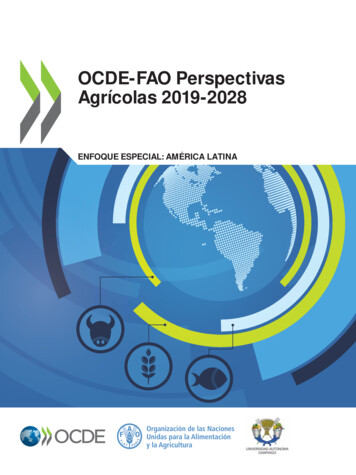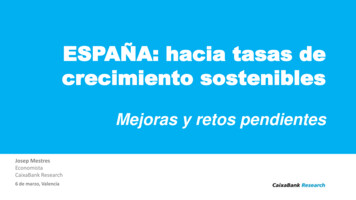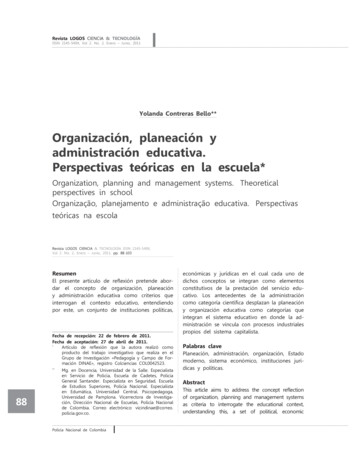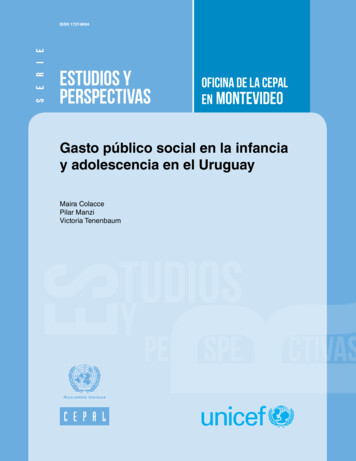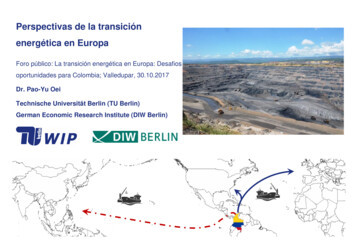
Transcription
Perspectivas de la transiciónenergética en EuropaForo público: La transición energética en Europa: Desafios yoportunidades para Colombia; Valledupar, 30.10.2017Dr. Pao-Yu OeiTechnische Universität Berlin (TU Berlin)German Economic Research Institute (DIW Berlin)-0-
Agenda1. Motivation2. Experiences from Germany and the EU3. Trends in USA, China and Indien4. Effects on the Global Coal Market5. Conclusion-1-
Publications on coal (selection) Oei and Mendelevitch (2016): Perspectivas sobre lasExportaciones de Carbon Colombiano. Oei and Mendelevitch (2016): Perspecitves on ColombianCoal Exports on the International Steam Coal Market until2030 Oei et al. (2016): „Kohlereserve“ vs. CO2-Grenzwerte in derStromwirtschaft – Ein modellbasierter Vergleich“,Energiewirtschaftliche Tagesfragen, 1-2/2016 Collins, and Mendelevitch (2015): Leaving Coal Unburned:Options for Demand-Side and Supply-Side Policies, DIWBerlin, DIW Roundup 87, Berlin, Germany. Richter, Mendelevitch and Jotzo (2015): Market PowerRents and Climate Change Mitigation: A Rationale for CoalTaxes?, DIW Berlin, DIW Discussion Paper 1471, Berlin,Germany. Holz, Haftendorn, Mendelevitch, and Hirschhausen (2015):The COALMOD-World Model: Coal Markets until 2030, in R.K. Morse and M.C. Thurber (Eds.) “The Global Coal Market Supplying the Major Fuel for Emerging Economies”.Cambridge University Press. Oei et al. (2014): Modeling a Carbon Capture, Transport,and Storage Infrastructure for Europe“. Journal ofEnvironmental Modeling and Assessment 05/2014-2-
Motivation: 70-90% of coal, 30-60% of gas and 30-60% of oilreserves has to stay unmined to reach the 2 C targetSource: McGlade & Ekins (2015)-3-
Times are changing for coalThe success of renewables (and lower gas prices in some regions) have lead to a reduction ofcoal demand in the western world. Several smaller countries in the EU are already coalfree or will phase-out in the 2020s.The Republic of China has introduced a moratorium on new coal power plants and mines andIndia is observing a much slower increase of coal demand than expected.As a result, steam coal production declined by around 28% between 2005 and 2015.Coal companies world-wide are struck with low prices and are challenged by ongoingdivestment movements.200USD15010050Eurozone CIFFOB Richards BayFOB NewcastleCrude oil0Source: HWWI- 4commodityprices in the Thompson Reuters Datastream database.-
Colombia s future as 4th largest exporter of steam coalThere exists a wide range of studies that put foci on various environmental and socialimplications of the coal mining industry in Colombia (e.g., see Moor and van de Sandt 2014;CAN 2016b; Hawkins 2014; Chomsky and Striffler 2014; CINEP/PPP 2014; Schücking 2013).Our research focus lies on: How will coal exporting countries, such as Colombia, be affectedby the decline of the coal industry?Doing so, requires an analysis of the competitiveness of the coal exporting country (in this case: Colombia), current market development in other coal producing and consuming countries, prospects for future Colombian coal exports.-5-
Agenda1. Motivation2. Experiences from Germany and the EU3. Trends in USA, China and Indien4. Effects on the Global Coal Market5. Conclusion-6-
Comparision of Colombia and GermanyPopulationGDP83 Mil.49 Mil.42.000USD/capita6.000USD/capita9 t/capita2 t/capitaCO2 Emissions-8-
Experiences from Germany: Employment in coal industryHard coal: 500.000 10.000Lignite: 150.000 30.000Colombia: 30.000 ?-9-
Coal capacities in Europe observe a decreasing trend.Coal free countries in the EU: BE, CY, EE, LT, LU, LV, MT20302025202520302040 ?2016202520252030Source: CAN database / Sandbag (2016)- 10 -
Cheaper renewable alternatives cause the drop in coal demandSource: Irena (2017).- 11 -
New jobs are being created in the field of renewables- 13 -
Agenda1. Motivation2. Experiences from Germany and the EU3. Trends in USA, China and Indien4. Effects on the Global Coal Market5. Conclusion- 14 -
The outlook for coal in the US is negative. The change ofnational government will not influence the global dynamics.The share of coal in total electricity generation declined from 52.3% in 2000 to 34.3%in 2015.Important drivers are federal and state level promotion of wind and solar energy aswell as environmental policies for coal-fired power plants.Numerous U.S. coal producers (including Peabody Energy Cooperation, Arch Coal Inc.,and Alpha Natural Resources, listed first, second and forth in the top four U.S. coalmining companies) have filed for bankruptcy and 271 mines were closed in the lastyears.The current U.S. administration, however, targets to take backclimate measures and announced to withdraw from theParis Agreement. However, the competitiveness of theUS domestic coal sector will be governed by theevolution of the gas price and cost of renewablesrather than by the rollback of the Trump Administration.Source: SPON (2017).- 15 -
The global coal power pipeline is currently observing a majorhault, dominated by the happenings in China and India [MW]Emerging countries are expecting rising energy demands due to population growthand economic development.China and India account for 86% of global installed coal power capacity 2006-2016.Many projects, however, were shelved in the last year.Coal capacities are displayed in GW; Source: Shearer et al. (2017).- 16 -
Dramatic changes to China’s coal pathway with a biguncertainty about future developments Electricity generated by coal peaked in2013, coal power capacity cap of 1,100GWto be reached in 2020 (921 GW installed asof January 2017; representing 47% of globalinstalled power capacity). Capacity factor of power plantsdecreased below 50% in 2015 and 2016. Plans to retire older coal power plants. Suspension of new plant approvals andhalt on construction in several provinces;Total amount of cancelled projects between2010 and 2016: 203 GW. Cancellation of100 specific plant projects from September2016 to January 2017. The implemented national climate and environmental policies resulted in ahault of coal consumption and a shift towards low carbon energy sources. The beginning of the Chinese coal phase-out came earlier than expected.Sources: Climate Action Tracker (2017a); Endcoal (2017a, 2017b); Isoaho (2016); Shearer et al. (2017).- 17 -
Status-quo of coal in India Installed coal capacity grew from 71 GW in 2007 to212 GW in January 2017 (11% of global capacity). Rapid expansion resulted in falling capacity factors. Leading coal power producers (e.g. Adani) suspendedinvestments and further development. Draft Electricity Plan: No new coal capacity neededbetween 2022-27, apart from the 48 GW already underconstruction. India implemented a tax on coal of US 3.2/t coal;revenues go to the National Clean Environment Fund.Coal capacities in 2017 [GW]Installedcapacity212 Indian coal consumption has grown muchslower than expected. India needs decentral renewable energysources to provide cheap energy access.Put on hold inPreviously undertotal (end 2016) construction put on hold8213Cancelledduring 2016PreconstructionActiveconstruction11512948- 18 - Sources: Climate Action Tracker (2017b); CoalSwarm (2017); Shearer et al. (2017)
Agenda1. Motivation2. Experiences from Germany and the EU3. Trends in USA, China and Indien4. Effects on the Global Coal Market5. Conclusion- 19 -
The upcoming coal phase out effects countries differently andtherefore needs a combination of various political instrumentsNeed to differentiate between countries:that only mine coal (e.g. Colombia) employment income from exportsthose burning coal (e.g. UK and many countries in Europe) energy security (employment)those doing both (e.g. US, China, India, South-Africa, Germany) energy security employment (income from exports)- 20 -
Coal phase-out concepts need to incorporate different regionalaspectse.g.ColombiaFinancial paymentsas compensation fora moratorium onnew minese.g.Europe orUSe.g.China orIndiaMoratorium on newminesMoratorium on newmines; maybe linkedwith compensations--------------------Existing coal powerplant fleets need tobe closedMoratorium for newplants to prevent(stranded) assetsSupport for RES tomeet rising energydemand, enableenergy access &create jobsSupport for RES toreplace fossilcapacities & createjobsSupport for RES tomeet rising energydemand, enableenergy access &create jobsActive & passivelabour marketinstruments toenable a justtransitionActive & passivelabour marketinstruments to enablea just transitionActive labour marketinstruments tocreate new jobs- 21 -
Mining Problems in Germany: Technical and EnvironmentalRisks of Iron Ocre: Threat for Individuals and TourismSource: www.reiseland-brandenburg.deSource: dapdSource: RBB- 22 -
Mining Problems in Germany: Economical Risks of LiabilitiesWhat happens if a company goesbancrupt with:-Jobs and Pensions-Renaturation-Compensation paymentsThings become complicated ifcompanys consist of multiple(international) subsidiaries(see owners of German mines ) Securing sufficient funds frommining companies as long asthey make profits- 23 -
Agenda1. Motivation2. Experiences from Germany and the EU3. Trends in USA, China and Indien4. Effects on the Global Coal Market5. Conclusion- 24 -
ConclusionDemand for (Colombian) Coal is shrinking fast in Europe andthe US.Alternative markets in China or India are unlikely.The majority of coal has to remain in the ground.?The phase-out of mining is resulting in several problems:- Liabilities,- Jobs,- Renaturation.Active joint effort can result in new solutions.- 26 -
Perspectivas de la transiciónenergética en EuropaForo público: La transición energética en Europa: Desafios yoportunidades para Colombia; Valledupar, 30.10.2017Dr. Pao-Yu Oei, pyo@wip.tu-berlin.deTechnische Universität Berlin (TU Berlin)German Economic Research Institute (DIW Berlin)- 27 -
Draft Electricity Plan: No new coal capacity needed between 2022-27, apart from the 48 GW already under construction. India implemented a tax on coal of US 3.2/t coal; revenues go to the National Clean Environment Fund. Indian coal consumption has grown much slower than expected. India needs decentral renewable energy



